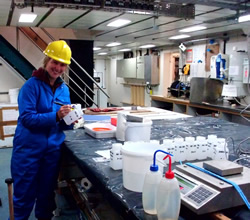Having joined the research cruise in Cork a few days ago I’ve been settling into my cabin, the new routine and the realization that I will be away at sea for the next four weeks. A bit daunting if you’re a first-timer like me, but everyone has gone out of their way to explain everything and make us welcome.
The vocabulary will probably take some getting used to; ‘Focstle’ was certainly a new and unpronounceable one for me. The hours might take a bit of getting used to as well. I’m on the 4pm to 4am shift, which is probably for the best, as we’re hoping to land the trawls in the dark to prevent photobleaching the pigments in the deep-sea fish eyes that we’re interested in. The first trawl will happen soon, but so far we’ve been helping Charlie out with some ‘megacoring’ on the Goban Spur, bringing up sediment cores from the ocean floor and processing them for subsequent analysis (see previous blogs). I’m sure there will be more posts about that from people who know more about it that me. All I can really say is that it seemed to have the texture of high quality potters clay – you’ll have to ask Milly what it tasted like!

So if I’m not an accomplished mega-corer what am I doing here? Our plan is to investigate the effects of pressure on the visual systems of deep sea fish. Light doesn’t penetrate down to the depths of the abyssal plain and yet the fish there have surprisingly well developed eyes. This is because they use bioluminescent signals to communicate, lure prey, hunt and startle predators. The pressure at the Porcupine Abyssal Plain (PAP) is almost 480 times atmospheric pressure at the surface. Organisms that live down there cannot avoid these huge pressures and must have evolved some incredible adaptations to cope with life in this apparently inhospitable environment. To investigate how fish are adapted for vision at high pressures, Nick Roberts at the University of Bristol in collaboration with Nick Brookes at Imperial College London have developed an imaging microspectrophotometer that can probe changes in the absorption spectrum of pigments in photoreceptors as they are pressurised. The missing piece in this experimental setup is now the deep sea photo-receptors themselves... so that is what Milly and I hope to collect during the cruise. How? well I’ll leave that to your imagination for the moment, first we need a trawl...

